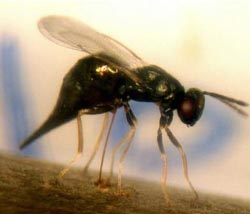Chinese wasps are taking on the emerald ash borer

Tetrastichus planipennisi is a parasitoid wasp used to control the emerald ash borer.<br><br>Credit: USDA Forest Service<br>
The emerald ash borer (EAB), a relatively new invasive insect pest, has killed tens of millions of ash trees throughout the eastern United States since it was first detected in 2002 in Michigan and Canada. This insect has the potential to kill an estimated seven billion ash trees in urban and rural forests and could cause tens of billions of dollars in damage.
To control the EAB, research on its natural enemies was initiated shortly after its discovery, resulting in a classical biological control program using three parasitoid wasps native to northern China, where the EAB populations in the US likely originated. After research on the biology, laboratory rearing, and host specificity of the three parasitoid species was completed in 2007, federal and state regulatory agencies approved their environmental release in more than a dozen states.
In an article appearing in the June issue of the Journal of Economic Entomology called “Establishment and Abundance of Tetrastichus planipennisi (Hymenoptera: Eulophidae) in Michigan: Potential for Success in Classical Biocontrol of the Invasive Emerald Ash Borer (Coleoptera: Buprestidae),” the authors observed one of the species, Tetrastichus planipennisi Yang, and found that the populations of these parasitoid wasps have been increasing and expanding in Michigan, which suggests that they will likely play a critical role in suppressing the EAB in that state.
These tiny wasps, which do not sting humans, lay eggs into or on the EAB larvae.
The researchers sampled trees for wasp broods at six forest sites near Lansing, Michigan. By the fall of 2012, the proportion of sampled trees with one or more broods of T. planipennisi increased from 33% to 92% in the plots where the wasps were released. Similarly, the rates of parasitism on the EAB increased from 1.2% in the first year after the parasitoid releases to 21.2%.
Journalists who would like an advanced copy of the article should request one by writing to pubs@entsoc.org or calling 301-731-4535, ext 3009.
DOI: http://dx.doi.org/10.1603/EC13047
The Journal of Economic Entomology is published by the Entomological Society of America (ESA), the largest organization serving the professional and scientific needs of entomologists and people in related disciplines in the world. Founded in 1889, ESA today has more than 6,000 members affiliated with educational institutions, health agencies, private industry, and government. Members are students, researchers, teachers, extension service personnel, administrators, marketing representatives, consultants, and hobbyists. For more information, please visit http://www.entsoc.org.
Media Contact
More Information:
http://www.entsoc.orgAll latest news from the category: Agricultural and Forestry Science
Newest articles

Compact LCOS Microdisplay with Fast CMOS Backplane
…for High-Speed Light Modulation. Researchers from the Fraunhofer Institute for Photonic Microsystems IPMS, in collaboration with HOLOEYE Photonics AG, have developed a compact LCOS microdisplay with high refresh rates that…

New perspectives for material detection
CRC MARIE enters third funding period: A major success for terahertz research: Scientists at the University of Duisburg-Essen and the Ruhr University Bochum have been researching mobile material detection since…

CD Laboratory at TU Graz Researches New Semiconductor Materials
Using energy- and resource-saving methods, a research team at the Institute of Inorganic Chemistry at TU Graz aims to produce high-quality doped silicon layers for the electronics and solar industries….



